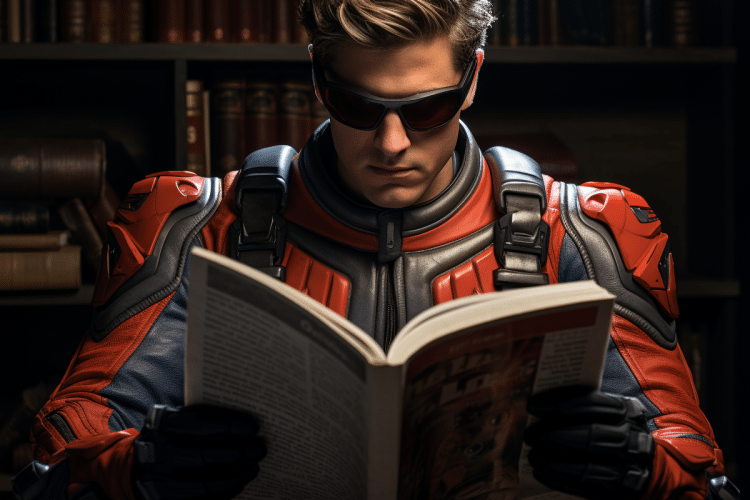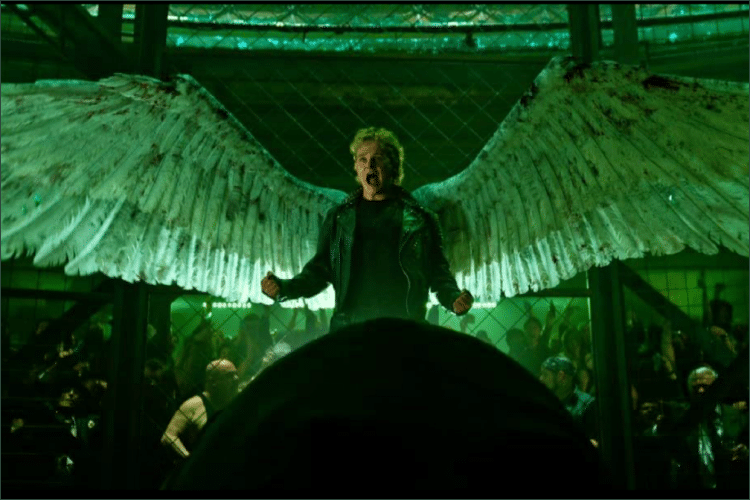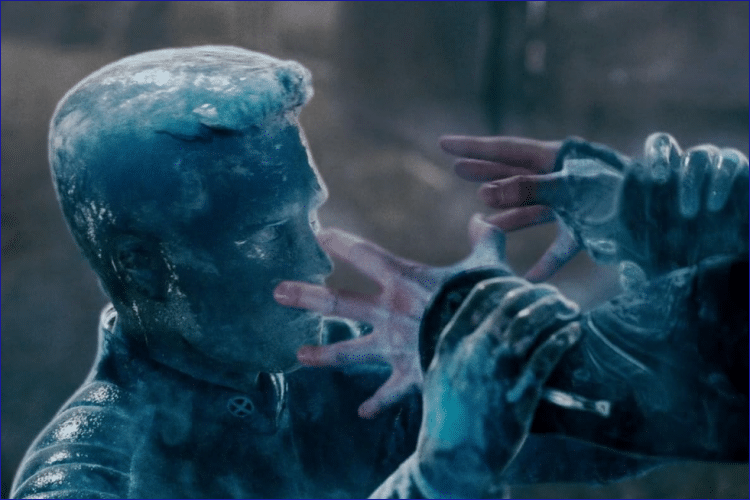Let’s Talk Shop, Heroes.
Dathon: “Uzani, his army with fists open.”
Star Trek the Next Generation “Darmok” (Season 5, Episode 2)
Picard: “A… strategy, with fists open? With fists open?”
Dathon: “His army with fists closed.”
Picard: “With fists closed. An army with fists open… to lure the enemy. With fists closed… to attack? That’s how you communicate, isn’t it, by… by citing example! By metaphor! [backs away] Uzani’s army with fists… open!”
Dathon: “Sokath, HIS EYES UNCOVERED!”
It’s funny how language changes. We have so many words that describe things, but new slang constantly enters our vocabulary. Someone’s cool? You know that means impressive rather than cold. People are sympathetic, not spooked, if you’re ghosted. Superhero comics aren’t just about capes and powers; they’ve got their own slang that packs a punch.
Superhero fans sound like we’re speaking Space Australian. Sentences like “Street-level hero Pantha was stuffed into the fridge during the Infinite Crisis event” make perfect sense, but will have non-fans phoning the nice men in white coats. Let’s demystify these tropes. Let’s find out five superhero terms you should know.
Scene Select
#5 Superhero Lingo: Rogues Gallery
The Shade: “Now I get it. You’re trying to set up another Injustice Gang, aren’t ya?”
Justice League “Secret Society” (Season 2, Episode 17)
Giganta: “We call it a society. A Secret Society.”
The Shade: “Call it what you want, it won’t work. I know, I’ve tried. Twice!”
Gorilla Grodd: “What’s that old saying? Third time’s the charm.”
You can often judge someone by their enemies. Sometimes only one person hates their guts. Other times, an entire organization could want their head on a pike. This superhero lingo is perfect for the fiends you made along the way.
A Rogues Gallery is the collection of supervillains a hero fights. Any costumed ne’er-do-well can join the gallery, but the most frequent foes are at its heart. Reusable rapscallions are invaluable for writers who don’t want to create a bad guy every month and adored by studios planning movies or shows.
The best Rogues Galleries have a unifying theme or reflect the hero. Spider-Man fights a zoo of animal-themed villains, including The Lizard, The Vulture, and Doctor Octopus. Batman’s Gallery is a dark mirror. The Penguin is Bruce’s aristocratic background, The Riddler is his intellect, and Scarecrow is Batman’s use of fear as a weapon. Every Rogues Gallery villain has some connection to a hero.
#4 Event/Crisis
Buffy: “This is how many apocalypses for us now?”
Buffy the Vampire Slayer “The Gift” (Season 5, Episode 22)
Giles: “Oh well, uh, six at least. Feels like a hundred.”
Team-ups and celebrity guest stars are easy ways publishers draw in readers, but lose their luster when overused. But what about a story where everyone must unite to save the day? Publishers love this bit of superhero lingo.
Event Comics are storylines that alter the status quo. They often feature hero team-ups, grandiose villains that can destroy worlds, and many character deaths to sell the high stakes plot. Smaller events focus on one hero and characters in their sphere of influence. Bigger events like The Crisis on Infinite Earths can reboot entire universes.
Marvel and DC adore Event Comics since they’re easier to market than individual issues. They can also sell many tie-ins to Events, showcasing related comics without interrupting their main story. Unfortunately, the Big Two publish multiple Events every year, changing things before the status can become quo, which leads to many superheroes joking about monthly apocalypses.
#3 Superhero Lingo: Plot Armor
Bing Crosby: “For any villains we may meet, we haven’t any fears”
Road to Morocco
Bob Hope: “Paramount will protect us cause we’re signed for five more years!”
Some characters are simply too important to die. Writers need to make sure someone will be around for the plot. This Superhero Lingo can protect anyone. Well, anyone who matters.
Plot Armor is the protection major characters have because of their role in the story. Major characters invariably survive battles or death traps with little effort because their presence is needed for the plot. Stormtroopers, Nazis, and other mooks will never kill the movie stars unless they need to be captured. Villains can’t be stopped until the dramatic final battle with the hero. And if something happens that should kill them, Plot Armored characters will pull something from their butt to prevail.
Plot Armor is the bane of prequels. You know that any character who appears in the original story is safe because they need to fulfill their later role. The brave hero is going to be executed or the beautiful princess kidnapped? They’ll be fine thanks to Plot Armor. It kills all tension and defangs fraught action scenes.
#2 Fridging/Stuffed Into The Fridge
Spider-Man: “I’m going to get you, Goblin! I’m gonna destroy you slowly, and when you start begging me to end it, I’m gonna remind you of one thing: YOU KILLED THE WOMAN I LOVE! AND FOR THAT, YOU’RE GOING TO DIE!”
The Amazing Spider-Man #121
Writing is hard work. Some authors struggle to convey how personal a hero’s battle is and naturally raise the stakes. This bit of superhero lingo describes a common shortcut that needs to go the way of the dodo.
Fridging means to kill, rape, maim, depower, or otherwise torment a female character to prop up someone else’s story. Murdered lovers are popular for cheap anger, personal fights, and endless reams of whining from the hero. Fridging survivors will have their trauma minimized except to focus on how it affects a hero. It only counts as fridging if the woman is thrown under the bus to develop someone else’s story instead of her own.
The name comes from Green Lantern #54 in 1994. A villain called Major Force broke in to GL’s home and murdered his girlfriend, Alexandra Dewitt. To taunt Green Lantern, Major Force stuffed her body into a refrigerator, and forged a note from her telling Green Lantern about a “surprise for you in the fridge.”
Then unknown comics writer Gail Simone worked with other female superhero fans to create Women in Refrigerators, a website coining the phrase and spotlighting heroines who had been fridged. Their work successfully influenced the industry and was a springboard for Simone’s later award-winning career in comics and on television.
#1 Superhero Lingo: Retcon
Doctor Doom: “Think, boy. If I am ever defeated or dishonored… If I ever act in ways unworthy of myself… If I ever die… The word goes out: “It must have been a Doombot.” And the reverse is true. My robots often confuse my foes. I may be a robot now, speaking these words. How would you know? How would I?”
Loki: Agent of Asgard #6
This final bit of Superhero Lingo is one of the most important to understand. There’s a reason it was the first subject I tackled when I joined Movie Rewind. Time for round 2.
Retcon is short for retroactive continuity. That means an author changing a character or story by revealing information that has always been in effect, but only revealed now. The comedic sidekick needs to chase a bad guy? Good thing they’ve always known how to drive a motorcycle. The love interest has been cut in half? They were an android the whole time and are okay.
Retcons are often used to change stories or characters that the author didn’t like. This can be good, like explaining away Green Lantern and Cassandra Cain’s villainy, or bad, as when Gwen Stacy and the Green Goblin had an affair. Writer disagreements can result in edit wars that muddle a story beyond comprehension.
Publishers will occasionally decide a slew of retcons are needed and reboot an entire universe, for better or worse. DC has done this at least four times in the comics and their movie universes followed suit by replacing the Snyderverse with the upcoming DCU. Nuking a universe like this is high risk, high reward.
What’s your favorite bit of Superhero Lingo? Is there a term we missed? Tell us in the comments.
Image: MidJourney 5.4 prompted by Jared Bounacos

Jared Bounacos has written for Movie Rewind since 2016.





Leave a Reply